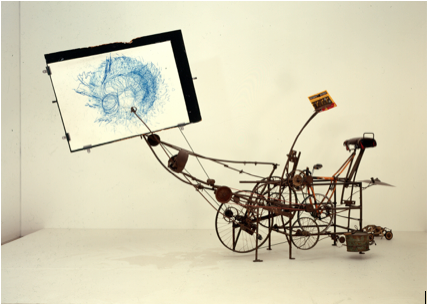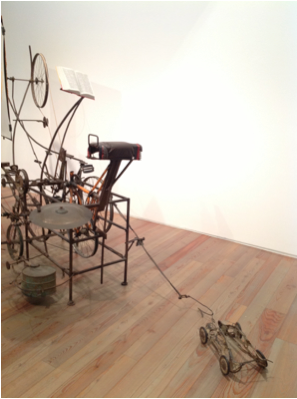Jean Tinguely’s Cyclograveur: The Ludic Anti-Machine of Bewogen Beweging

Bewogen Beweging (Moved Movement) was an exhibition held at the Stedelijk Museum, Amsterdam, from March 10 to April 17, 1961. Curated by two museum directors—the Stedelijk’s Willem Sandberg and Pontus Hultén, from the Moderna Museet, Stockholm—together with artists Daniel Spoerri and Jean Tinguely (1925–1991),[1] the show constituted a survey of Kinetic art as it presented nearly two hundred works by over seventy artists, all of whom contributed to the novel spectacle of rusty wheels, chains, broken typewriters, strollers, and alarm clocks that moved and made noises. Many of the works on display incorporated bicycles in various forms.[2] A Netherlandish metaphor for both play and utility, the bicycle is at once a child’s toy and the predominant mode of transportation for adults in Amsterdam. Examining in particular Tinguely’s Cyclograveur—a sculpture based primarily on the bicycle—this essay reveals that the exhibition deployed the illogical movements of mechanical components in a ludic critique of the rapid industrialization and modernization of the Netherlands after World War II.
Tinguely was well represented in Bewogen Beweging, with twenty-eight works on display.[3] He constructed his Cyclograveur of rusty parts scavenged from bicycles, automobiles, and baby carriages (Figure 1).[4] The saddle, originally a two-person motorcycle seat installed sideways, was placed on a post twice the height of that of a typical bicycle, while the pedals were connected to several gears and four wheels. A large drawing board extended about a meter beyond the pedals. Cyclograveur became kinetic when a museumgoer climbed onto the bicycle to push the pedals. This action caused a fifth wheel behind the drawing board to rotate around the surface via lanky arm-like metal rods while another rod, positioned in front of the board, held a drawing implement that would create an artwork. The bare bones of a toy car were towed behind the Cyclograveur, as if from an appendage, in a metaphor of subordination that mocked the ascendancy of the automobile (Figure 2). Typical of Tinguely’s works, the artist attached a cymbal and an upside-down metal bucket drum that were struck by mallets, reminiscent of a one-man band, to augment the already ridiculous clamor of the rickety machine. Tinguely had created an anti-machine beneath a veneer of fun, the absurdity of which softened his critique of modern mechanization while at the same time inviting reconsideration of it.
Rather than directly confronting the blind embrace of modernization, Tinguely employed humor to allow room for the viewer to form his or her own judgment. In his 1975 book Art: Action and Participation, art historian Frank Popper (b. 1918) examines Cyclograveur’s place in Kinetic art.[5] Explaining how critique functioned by way of humor in Tinguely’s work, Popper writes:
“For Tinguely, we must bear in mind, the machine incarnates human intelligence: its beauty as well as its capacity for movement help to explain its attraction for him. Thus we can expect that the metamorphoses of the machine will bring about a corresponding dynamic effect in the spectacle, which reaches the ‘summit of absurdity’ through its own intrinsic logic.”[6]
The absurdity of a machine endowed with human characteristics addressed the Dutch anxiety about rapid industrialization by poking fun at the “promises” of automation. By presenting a purposeless object that subverted the functionality of the very purposeful bicycle, Cyclograveur humorously encouraged visitors to question their presumptions about machines and their expectations of the coming “machine age”.

Anxiety over technological advances was not new in the 1960s. French philosopher Henri Bergson (1859–1941) was distressed by the increasing mechanization of the modern world, a notion that informed his central belief about what generates laughter. In his study Laughter: An Essay on the Meaning of the Comic (1911),[7] Bergson describes the comical as “something mechanical encrusted on the living.” As an example, Bergson cites a man tripping and falling. The humor in such an act is found in a man’s “lack of elasticity.”[8] In this example, the unfortunate man “continued like a machine in the same straight line” demonstrating a “mechanical inelasticity.”[9] For Bergson, humor is man’s embodiment of machine-like characteristics: the inability to catch his balance by spontaneously reacting to changes in the environment, as early machines could not adjust to obstacles. But while Cyclograveur addressed anxiety about machines, its humor is found in the inverse of Bergson’s principle. Here, the comical is not embodied in a human assuming mechanical characteristics, but rather in Tinguely’s machine becoming anthropomorphic. As Popper articulates, we see the artwork adopt peculiarly human traits, such as the capacity to create. The very ludicrousness of the comical machine and its imperfect human operator demands that the viewer reconsider both.
This conflation of man and machine evidently struck a chord with Dutch audiences in the 1960s. Nearly all the reviews of Bewogen Beweging reference Tinguely’s anti-machines—and frequently Cyclograveur—in their texts or illustrations.[10] For example, a reviewer in the progressive newspaper Vrij Nederland writes of Tinguely’s contributions: “His machines are as messy as people, but they still work miraculously and present a balanced slapstick,” and continues, “there are a lot of laughs at ‘Bewogen Beweging’, and not laughing at but laughing with the exhibition.”[11] This comment on the amusing quality of the show highlights a problem inherent in ludic art: due to its playful nature Cyclograveur was misunderstood by some as merely innocuous humor.
While some critics paid more attention to the spectacle apparent in Cyclograveur and Bewogen Beweging, a more sophisticated and nuanced view also emerged at the time. A review in the left-wing newspaper Volkskrant asserts that the exhibition was “an attack on the technocracy of our time,” although it continues to point out the lightheartedness of the show: “the grotesque and utterly useless, but diligently moving constructions, which you bump into here, are trying to be a witty provocation—certainly a challenge to the mechanization of all that is human.”[12] As the anonymous Volkskrant review suggests, exhibiting non-functional machines, or anti-machines, constitutes a critique of postwar functionalism and an alternate view of the social norms of the previous decade.[13]
As did all the works in Bewogen Beweging, Tinguely’s Cyclograveur addressed the postwar transformation in Dutch society.[14] But while Tinguely was critiquing the increasing mechanization of modern society, what resonated most powerfully with Dutch audiences was that he communicated in a language that every Dutchman understood: Tinguely spoke Bike.
Janna Schoenberger
Endnotes:
Unless otherwise indicated, translations are the author’s.
[1]After its stay at the Stedelijk Museum, Bewogen Beweging traveled to the Moderna Museet under the title Rörelse Konsten (Movement in Art), with additions by Tinguely, including his Ballet des Pauvres (Ballet of the Poor).
[2] One artwork based on a bicycle, Robert Müller’s La Veuve du Coureur (1957), received press attention because it was deemed “pornographic.” It was a gray, elongated version of a stationary bicycle that looks as though the frame of a bicycle had merged with a coat rack. Müller had carved a hole in the saddle through which protruded a cream-colored phallic object. The object was rigged to the chain in such a way that it would move up and down through the hole while the apparatus was pedaled. Criminal charges were levied against Sandberg for displaying the work, but were eventually dropped. When the press asked about the affair, Sandberg quoted from the Bible (in German): “Dem Reinen ist alles Rein” (To the pure, all things are pure). The director’s wit echoed the ludic nature of the exhibition. “Geen vervolging om ‘de Weduwe’,” April 22, 1961, Knipselmap Bewogen Beweging, Stedelijk Museum Amsterdam.
[3] Spoerri, on the other hand, acted solely as a curator without contributing artwork. Most artists were represented by one to three works, but a few showed more: Pol Bury (7), Alexander Calder (8), Marcel Duchamp (7), Robert Müller, (6), Bruno Munari, (6), Man Ray (9), Dieter Roth (8), Nicolas Schöffer (7), and Raphael Soto (10). The relative degrees of representation reflect these artists’ association with the avant-garde or Kinetic art or both.
[4] While Cyclograveur (Bicycle Engraver) is presented in Tinguely’s Meta-matic (Drawing Machine) series in Museum Tinguely’s collection in Basel, the term graveur suggests that the machine engraved rather than drew; in fact, it could be equipped to do either. The work is described in great detail in the review: “Pijltje gooien naar een vast gespijkerd overhemd,” March 09, 1961, Knipselmap Bewogen Beweging, Stedelijk Museum Amsterdam.
[5] Popper did not identify Tinguely’s work by its title, but rather described it as his “bicycle seat sculpture (1961),” in which “the spectator actually pedals the bicycle.” Frank Popper, Art: Action and Participation (New York: New York University Press, 1975), 216.
[6] Ibid.
[7] Henri Bergson, Laughter: An Essay on the Meaning of the Comic (1911), trans. Cloudesley Brereton and Fred Rothwell (Dover Publications, 2005), 18; 24.
[8] Ibid., 5.
[9] Ibid.
[10] Two articles stand out for reproducing images of Tinguely’s work, especially Cyclograveur, thereby demonstrating the greater attention paid to his artwork: “ ‘Bewogen Beweging’ beweegt,” March 15, 1961, Knipselmap Bewogen Beweging, Stedelijk Museum Amsterdam; and, “Bewegende kunst in Stedelijk Museum van Amsterdam: Extreme gemotoriseerde oud-ijzer formaties,” March 25, 1961, Knipselmap Bewogen Beweging, Stedelijk Museum Amsterdam. Not all the critical attention was positive. In one article, “The Bicycle Repairman’s Nightmare,” the author admits that he does not understand the work, but then proceeds to give an earnest detailed mechanical analysis of Cyclograveur, explaining the flaws in the workings of the wheel and chain. This review, while perhaps not enlightening from an art-critical standpoint, shows how the formal qualities of Tinguely’s work attracted the attention of a wide audience. Moreover, it underscores the seriousness with which Dutch audiences regarded their bicycles. “De nachtmerrie van een fietsenmaker,” March 17, 1961, Knipselmap Bewogen Beweging, Stedelijk Museum Amsterdam.
[11] Ibid.
[12] “Potsierlijke anti-machines in Stedelijk Museum,” March 15, 1961, Knipselmap Bewogen Beweging, Stedelijk Museum Amsterdam.
[13] The majority of reviewers, however, failed to recognize the political import of the exhibition, viewing it instead as innocuous carnivalesque fun. V.d. W, “Bewogen Beweging,” April 13, 1961, Knipselmap Bewogen Beweging, Stedelijk Museum Amsterdam.
[14] Undergoing industrialization later than its neighbors Belgium and Germany, the Netherlands experienced a dramatic increase in industrial production during World War II, which continued through the 1950s. James Kennedy, Nieuw Babylon in aanbouw: Nederland in de jaren zestig, trans. Simone Kennedy-Doornbos (Amsterdam: Boom, 1997), 10 –12.